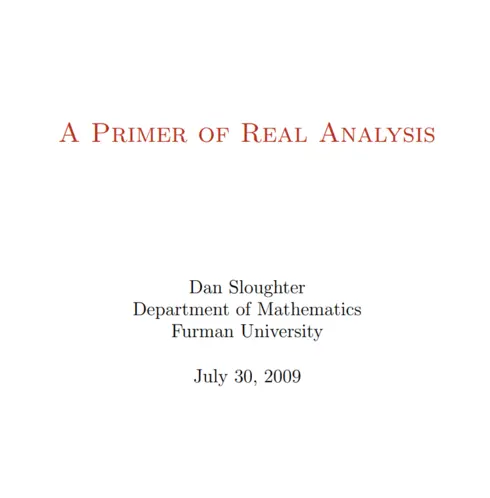
A Primer of Real Analysis
![]()
![]()
![]()
![]()
![]()
Dan Sloughter, Furman University
Copyright Year:
Publisher: Dan Sloughter
Language: English
Formats Available
Conditions of Use
![]() Attribution-NonCommercial-ShareAlike
Attribution-NonCommercial-ShareAlike
CC BY-NC-SA
Reviews
Reviewed by Seonguk Kim, Assistant of Professor of Mathematics, DePauw University on 9/20/19
This book consists of all essential sections that students should know in the class, Analysis or Introduction of Real Analysis. First, in chapter 1, it has crucial prerequisite contents. Second, from chapter 2 to 8, the order of sections is... read more
![]()
![]()
![]()
![]()
![]()
Reviewed by Seonguk Kim, Assistant of Professor of Mathematics, DePauw University on 9/20/19
Comprehensiveness
This book consists of all essential sections that students should know in the class, Analysis or Introduction of Real Analysis. First, in chapter 1, it has crucial prerequisite contents. Second, from chapter 2 to 8, the order of sections is reasonable and well-organized. But some instructors may skip chapters, 3, 4 and 8 because of the limit of time. Finally, I like the composition adding the exercises after the theorems because the student may be able to have ideas much easier.
Content Accuracy
The content looks good and little error. Even though some notations are ambiguous and not easily understandable, overall is good.
Relevance/Longevity
In the class, Analysis, students learn about the fundamental mathematical structures and concepts, and the related textbook also does not have any space adding the up to date contents. Nevertheless, I feel that this textbook provides a new view of the concepts.
Clarity
All text is from the mathematics terminology that makes the writing lucid and readable.
Consistency
In every chapter, it has used consistent letters and terminologies. Also, the composition is uniform using the order,
1. A brief description of the concepts,
2. Related definitions
3. Theorems
4. Examples
5. Exercise students should think about more.
Modularity
The book breaks into separated sections, and each part is short and consists of readable and accessible text.
Organization/Structure/Flow
The order of topics is in general. But it depends on the instructors. For example, I like to introduce the basic concepts, sets including cardinality (chapter 3), functions, logics before starting the sequences. Also, I have explained the idea, topology (chapter 4). So, in my opinion, it is better to organize the order of topics from fundamentals, including cardinality to more functions and to add the appendix, topology.
Interface
This text has a lot of essential and useful figures and formulas. I believe the figures and graphs make students understand more easily.
Grammatical Errors
It looks no grammatical errors. At least, I could not find them.
Cultural Relevance
This textbook is for pure mathematics. So, I believe it has no inclusive issues about races, ethnicities, and backgrounds at all.
CommentsOverall, the textbook is very well-organized. I like the way how to organize the chapters. It is essential and nothing of unnecessary sections. Specifically, I like the composition adding the exercises after theorems and examples. If I use the book, I do not have to add more examples and suggest the students with the exercise problems. There are also some drawbacks to the book like ordering the topics. Nevertheless, I value this book in teaching the course Analysis.
Table of Contents
1 Fundamentals
- 1.1 Sets and relations
- 1.2 Functions
- 1.3 Rational numbers
- 1.4 Real Numbers
2 Sequences and Series
- 2.1 Sequences
- 2.2 Infinite series
3 Cardinality
- 3.1 Binary representations
- 3.2 Countable and uncountable sets
- 3.3 Power sets
4 Topology of the Real Line
- 4.1 Intervals
- 4.2 Open sets
- 4.3 Closed sets
- 4.4 Compact Sets
5 Limits and Continuity
- 5.1 Limits
- 5.2 Monotonic functions
- 5.3 Limits to infinity and infinite limits
- 5.4 Continuous Functions
6 Derivatives
- 6.1 Best linear approximations
- 6.2 Derivatives
- 6.3 Mean Value Theorem
- 6.4 Discontinuities of derivatives
- 6.5 l'Hˆopital's rule
- 6.6 Taylor's Theorem
7 Integrals
- 7.1 Upper and lower integrals
- 7.2 Integrals
- 7.3 Integrability conditions
- 7.4 Properties of integrals
- 7.5 The Fundamental Theorem of Calculus
- 7.6 Taylor's theorem revisited
- 7.7 An improper integral
8 More Functions
- 8.1 The arctangent function
- 8.2 The tangent function
- 8.3 The sine and cosine Functions
- 8.4 The logarithm function
- 8.5 The exponential function
Index
About the Book
This is a short introduction to the fundamentals of real analysis. Although the prerequisites are few, I have written the text assuming the reader has the level of mathematical maturity of one who has completed the standard sequence of calculus courses, has had some exposure to the ideas of mathematical proof (including induction), and has an acquaintance with such basic ideas as equivalence relations and the elementary algebraic properties of the integers.
About the Contributors
Author
Dan Sloughter has been teaching Furman students since 1986, and became Professor of Mathematics in 1996. He previously served as an assistant professor at Santa Clara University from 1983-86, and at Boston College from 1981-83. He was also an instructor at Dartmouth College from 1979-81.
